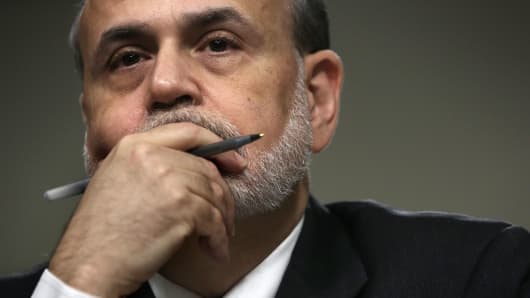Aside from mild relief rallies the likes of which came Tuesday, markets have been wobbly since essentially mid-June when Fed Chairman Ben Bernanke provided the first vivid clues about when the Fed would begin to pull back on the third leg of QE.
(Read more: Taper Tipoff? Bernanke Hints Easing End Is Nearing)
But what the market is getting wrong is the impact such a pullback might have.
Even if the Fed does begin tapering, it will do so only in a gradual manner of maybe $10 billion a month—"like missing one day of (Permanent Open Market Operations)," Ferry said—while continuing to engineer a low interest rate environment.
It seeks to achieve the latter objective in part through forward guidance of where it will go with interest rates.
Though Bernanke has been clear that the asset purchases will unwind well in advance of an increase in interest rates, the market hasn't listened.
Instead, it has pushed up the 10-year Treasury note yield past 2.8 percent from 2.33 percent when Bernanke delivered the first tapering comments. Yields also have risen in other global markets in response to the Fed's anticipated course, with the decline in India's rupee currency of particular concern.
(Read more: Almost everyone ismisreading Fed's new QE study)
This is the main danger with Fed policy—that day when the central bank begins to lose control of the rate structure and the market takes over.
Ferry said the Fed is actually subverting its goals through the use of forward guidance, which projects at this point that the Fed will keep rates where they are well into 2015. It has set a 6.5 percent unemployment rate and 2.5 percent inflation wall as the point where rates could start increasing, but Fed economic forecasting has been consistently inaccurate through the years.
(Read more: Unemployment rates rise in most states)
"Forward guidance is causing a spot on the horizon two years out, beyond which is chaos," Ferry said. "I'm anti-transparency in this mode and anti-forward guidance, because forward guidance is holding down the feedback loop that markets will give the Fed."
"What they're saying is our forecasts go out the window after 2015, because the market doesn't align with those forecasts now," he added.
Markets will be paying special attention to the Fed this week as two important events hit: The release of minutes from the July meeting Wednesday, followed by the Kansas City Fed summit at Jackson Hole, Wyo., starting Thursday.
The minutes will provide a further peek into the mindset of the 12-member Open Markets Committee, which ultimately sets Fed policy under Bernanke's guidance.
(Read more: Looking for Fedclues? Forget about Jackson Hole)
By contrast, any significant news out of Jackson Hole likely will move markets only because so little is expected, with Bernanke not attending and Vice Chairman Janet Yellen—a possible Bernanke successor—not on the docket to make any policy speeches.
"Changes in the minutes that would suggest a heightened probability of enhanced forward guidance could include many members emphasizing the importance of keeping the overall level of monetary accommodation high, despite a shift in the 'mix' of accommodation, to borrow Chairman Bernanke's phrase," Goldman Sachs economist Kris Dawsey said in a note to clients.
Dawsey predicted that the debate over QE against forward guidance "will continue to be a hot topic at this year's (Jackson Hole) conference."
A market looking for guidance is likely to susceptible to any level of surprise in policy.
"Investors need to get comfortable with the idea that the Fed is going to taper," said Kristina Hooper, U.S. head of investment and client strategies for Allianz Global Investors. "We've had some time to digest it. And it's going to happen eventually. But it's also important to understand that monetary policy will remain accommodative and supportive of risk assets."
—By CNBC's Jeff Cox. Follow him @JeffCoxCNBCcom on Twitter.





